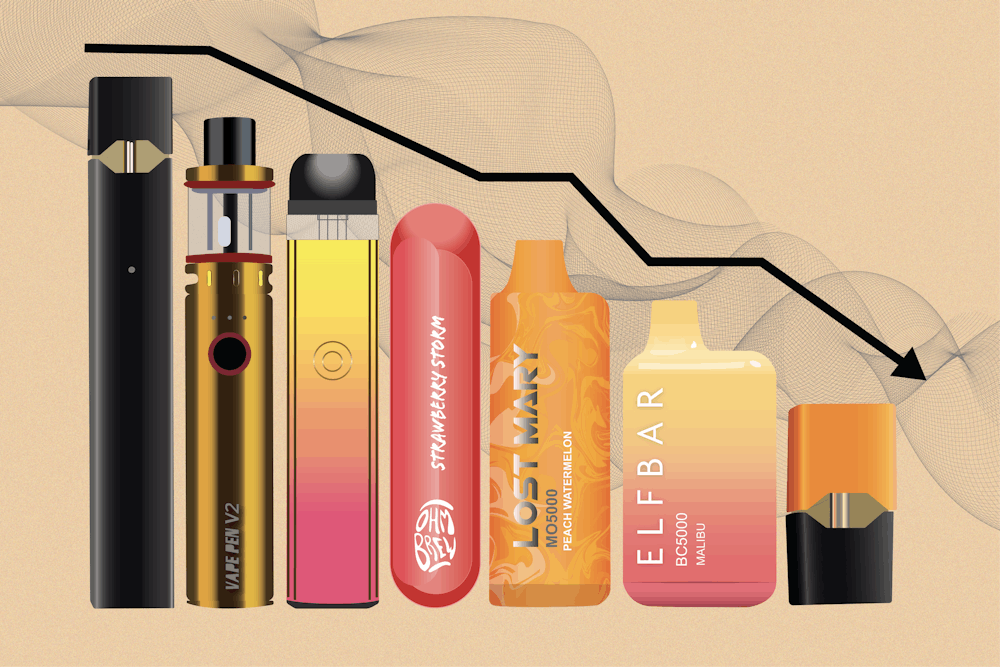This story is syndicated from The Daily Tar Heel, the newspaper of the University of North Carolina. The original version of the story ran here.
Use of e-cigarettes declined from 14.1 to 10 percent among high school students from 2022 to 2023, according to this year’s Centers for Disease Control and Prevention National Youth Tobacco Survey.
This 2023 decline comes about two years after N.C. Attorney General Josh Stein reached a $40 million settlement in his lawsuit against JUUL, an e-cigarette company. JUUL began paying the settlement in 2021 and will continue until 2027, according to a press release on Stein’s website.
The company was required in the settlement to make changes to its business practices to avoid appealing to younger people and fund programs to prevent e-cigarette addiction in North Carolina.
It is illegal to sell tobacco products to people under 21 years old.

Seth Noar, a distinguished professor in the Hussman School of Journalism and Media who specializes in health communication, said a reason for the recent decline could be because e-cigarette use rates in 2019 were the highest they had been in nearly two decades after the emergence of products like JUUL.
According to the National Youth Tobacco Survey, 27.5 percent of high school students used e-cigarettes in 2019.
The Orange Partnership for Alcohol and Drug Free Youth, which has been working to prevent youth substance use since 2008, collaborates with Orange County Schools, Gayane Chambless, the program director for the partnership, said.
Chambless said the partnership has historically encouraged peer education about vape-related harms in local middle and high schools. Peer education allows students to identify concerns about vaping and how the partnership plan to address it, she said.
According to Chambless, peer education was also beneficial in discovering the right needs for high school students.
“What we saw was the high schoolers’ response being, ‘It’s not helpful,’ because they were already addicted,” she said.
She said high school students often need more resources to quit vaping, rather than prevention resources.
“Being able to hear what is needed by those in the community that you’re serving is really important,” she said.
Noar said he researches health communication, specifically messages about vaping and e-cigarette usage. He said the most effective campaigns among high school students are messages about the health impacts of vaping.
“What seems to work the best is really trying to help young people understand what it’s like to be addicted, the consequences and the negative impact that addiction can have on your life,” Noar said.
PAVe, Parents Against Vaping e-cigarettes, is an organization dedicated to helping parents recognize warning signs of children vaping, giving them resources on how to help their children quit and educating parents, according to Shana Bedi, the education and regional advocacy manager for PAVe.
Bedi said PAVe was started by parents who had no public health background, but who felt their children were being targeted by the e-cigarette industry in schools.
In addition to educating parents, she said PAVe also works with all adults who come into contact with children who are vaping — including teachers, superintendents, principals, counselors and school nurses
Bedi said most young people who start vaping either experience pressure from their peers or underlying mental health issues. She said it is important to address these root causes of e-cigarette use to prevent people from becoming addicted.
Chambless said the Orange Partnership received a Partnerships for Success grant from the Substance Abuse and Mental Health Services Administration that totals $1.8 million over five years for Orange County.
She said the partnership has been researching what factors are causing mental health issues and increased substance use in high school students. She said one reason is lack of social engagement, especially after the COVID-19 pandemic.
To get the day’s news and headlines in your inbox each morning, sign up for our email newsletters.
The grant will be used to address this issue and create more pro-social opportunities for students in schools, she said.
Though there has been a decline in high school students using e-cigarettes, Bedi said PAVe will not reach its goal until rates drop to zero percent.
“We don’t want any kids vaping, we don’t want the industry targeting our kids,” she said.



